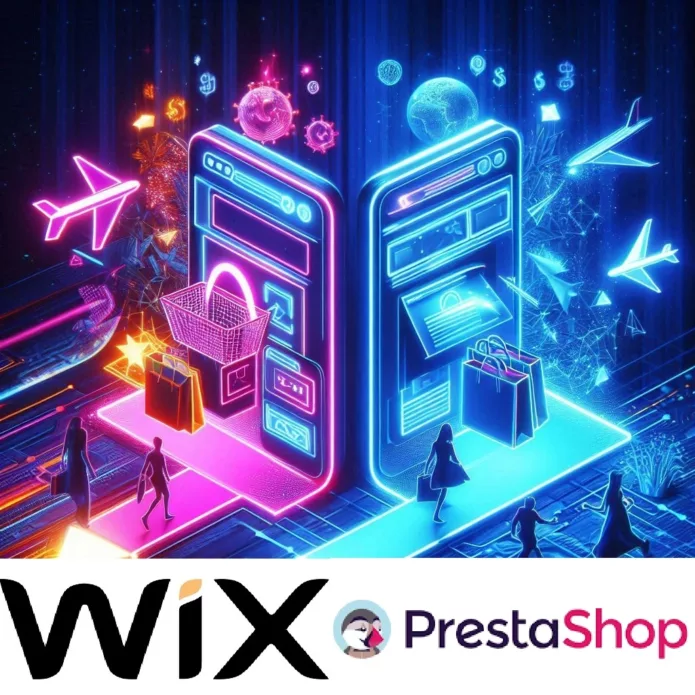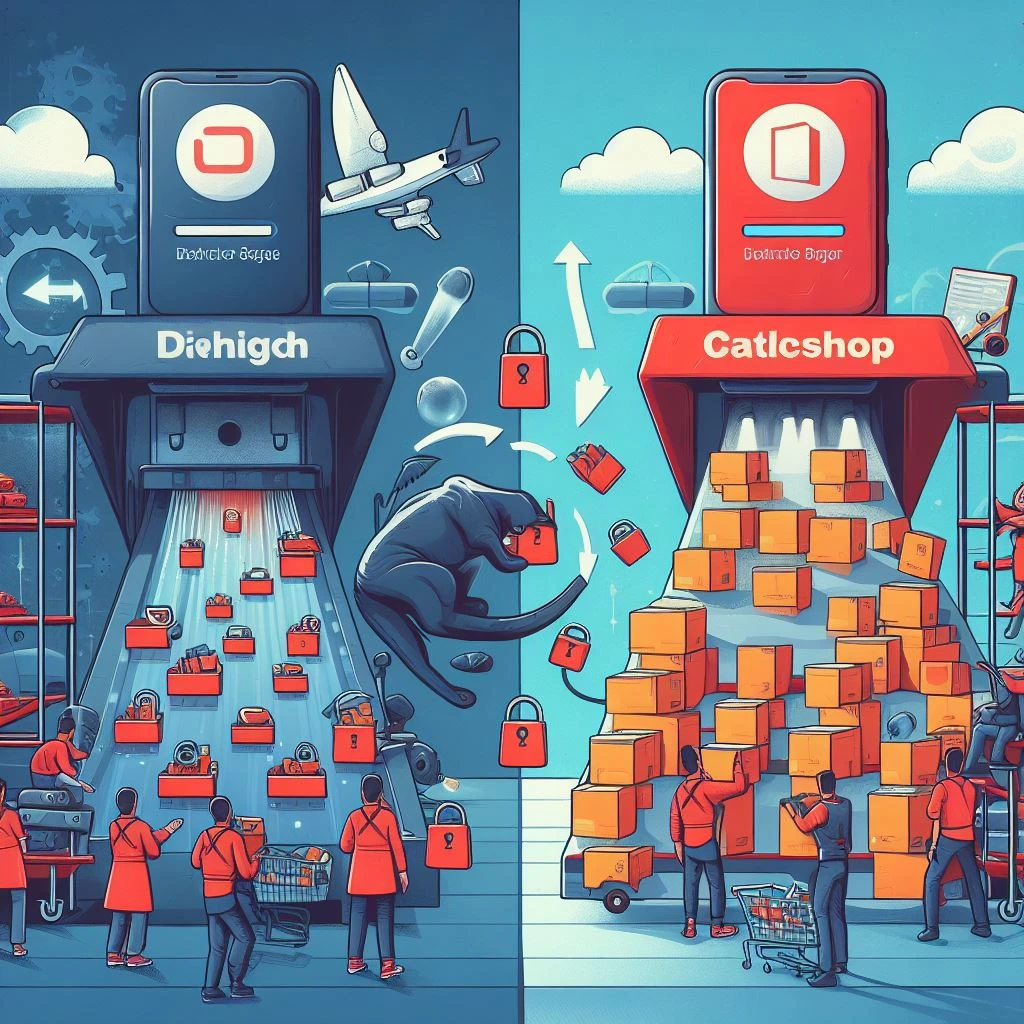In order to decide which ecommerce platform to use, WiX vs Prestashop. A detailed comparison between features must be thoroughly done. If you want to decide which eCommerce platform to choose, there are many things to consider.
These are some examples of these factors:
- Cost.
- SEO friendliness.
- Page load speed.
- Canonical website URL.
- Indexing Control.
- Customizable HTML capabilities.
- Sitemap Generator.
- Integration with Google Analytics.
- Product Tagging and Categorization.
- Batch Uploading.
- Mobile Optimization.
- Built-in Blogging and Marketing Features.
- Social Sharing Buttons.
- Content Management Capabilities.
- Discount and promotion code tools.
- Easy to use Checkout.
- Reporting tools and custom reports.
- Integration of email marketing tools.
- Multiple payment options.
- Flexibility to add new eCommerce features.
- Exclusive features.
- Cons and pros.
Here we’ll discuss these factors to help you decide which platform is better for you, Prestashop or WiX. And at the end of the discussion, we’ll recap and make a comparison for the scores of all these points to find out which eCommerce platform has the higher score, so that you’ll have a good view about both of them.

Pricing (WiX vs Prestashop):

Wix Pricing:
- Freemium Plan: Wix offers a free plan that allows you to build a basic website with limited features and Wix branding on your domain name. You can’t sell products on the free plan.
- Paid Plans: Wix offers several paid plans ranging from around $16 to $59 per month. These plans remove Wix branding, connect your custom domain name, allow online sales through Wix Stores, and offer increased storage and bandwidth.
- App Market Costs: On top of the base subscription fee, Wix offers an App Market with various apps that can add functionalities to your online store. These apps often have monthly fees or per-transaction costs, which can add up to your overall expenses.
PrestaShop Pricing:
- Open-Source Software: PrestaShop itself is free to download and use. This means you don’t pay PrestaShop directly for the software.
- Hidden Costs: However, running a PrestaShop store involves several hidden costs that you’ll need to factor in:
- Web Hosting: You’ll need to pay a web hosting provider to store your PrestaShop website and online store data. Prices vary depending on the hosting provider and the resources you need.
- Domain Name: You’ll need to purchase a domain name for your online store. This typically costs around $10 to $15 per year.
- Module Costs: PrestaShop offers a marketplace with modules (similar to Wix apps) that can add functionalities to your store. These modules can be free or premium, with premium modules often requiring a one-time fee or a monthly subscription.
- Development Costs: If you need customizations beyond what modules offer or require technical assistance with setting up PrestaShop, you might need to hire a developer, which can be an additional cost.
Here’s a table summarizing the key points:
| Platform | Pricing Model | Pros | Cons |
|---|---|---|---|
| Wix | Freemium with Paid Plans & App Market Costs | Easy to use, predictable monthly costs | Limited features on free plan, app marketplace costs can add up |
| PrestaShop | Free Open-Source Software (with Hidden Costs) | Highly customizable, potentially lower overall costs | Requires technical knowledge or additional costs for development, ongoing costs for web hosting and domain |

SEO Capabilities (WiX vs Prestashop):

Wix SEO:
- Ease of Use: Wix offers a user-friendly interface for managing basic SEO elements like meta descriptions, title tags, and URL slugs. However, it might lack advanced SEO features compared to other platforms.
- Built-in SEO Tools: Wix provides essential SEO tools like sitemap generation, robot.txt control, and mobile-friendliness features that contribute to SEO performance.
- Limited Control: Wix offers less control over certain technical SEO aspects compared to PrestaShop. You might have limited ability to optimize website structure or code for search engines.
- Wix SEO Wiz: This tool guides you through basic SEO setup steps like keyword selection and meta descriptions.
PrestaShop SEO:
- Greater Control: PrestaShop offers a high degree of control over technical SEO aspects. You can edit website structure, optimize page loading speed, and implement advanced SEO strategies.
- Flexibility: PrestaShop allows for the installation of SEO modules that can extend your store’s SEO functionalities. These modules can offer features like automatic internal linking, image optimization, and schema markup implementation.
- Steeper Learning Curve: Optimizing SEO in PrestaShop requires more technical knowledge compared to Wix. You might need to consult a developer or rely on SEO modules that require configuration.
- Potential for Errors: With greater control comes greater responsibility. Improper SEO implementation on PrestaShop can negatively impact your search engine ranking.
Here’s a table summarizing the key points:
| Platform | SEO Capabilities | Pros | Cons |
|---|---|---|---|
| Wix | User-friendly interface, built-in tools, Wix SEO Wiz | Easy to use, good for beginners | Limited control, less advanced features |
| PrestaShop | High level of control, module flexibility | Powerful SEO capabilities, potential for advanced strategies | Steeper learning curve, potential for errors |

Page Load Speed (WiX vs Prestashop):

Wix:
- Generally Faster Out-of-the-Box: Wix stores tend to have faster loading speeds out-of-the-box compared to PrestaShop. This is because Wix manages the server infrastructure and optimizes resources for its platform.
- Limited Control: However, you have limited control over factors that can affect page speed on Wix. Wix takes care of optimization on their end, but you can’t directly tweak technical aspects like server configuration or caching mechanisms.
- App Market Impact: Adding functionalities through the Wix App Market can potentially slow down your store if not chosen carefully. Complex apps or a high number of apps can increase page load times.
PrestaShop:
- Slower Potential Out-of-the-Box: PrestaShop stores can have slower loading speeds initially compared to Wix. This is because PrestaShop is self-hosted, and the speed depends on your chosen web hosting provider and server configuration.
- Greater Control: PrestaShop offers more control over factors affecting page speed. You can optimize server settings, caching mechanisms, and image compression techniques to improve loading times.
- Optimization Expertise Required: Optimizing page speed on PrestaShop requires some technical knowledge or the help of a developer. Improper optimization can even lead to slower loading times.
Here’s a table summarizing the key points:
| Platform | Page Load Speed | Pros | Cons |
|---|---|---|---|
| Wix | Generally faster out-of-the-box | Easier to maintain good speed, less technical knowledge required | Limited control over optimization |
| PrestaShop | Slower potential out-of-the-box, but highly optimizable | More control over speed optimization | Requires technical knowledge or developer assistance, potential for errors during optimization |

Canonical Website URL (WiX vs Prestashop):

Wix:
- Automated Management: Wix generally handles canonical URLs automatically. Wix assigns a canonical URL to each page on your store, and you typically don’t need to worry about manual configuration.
- Pros: Easy to use, no manual configuration required.
- Cons: Limited Control: You might have limited control over customizing or troubleshooting any canonical URL issues on Wix.
PrestaShop:
- Manual Configuration: PrestaShop requires more manual configuration for managing canonical URLs. You might need to edit themes or use modules to set preferred canonical URLs for your store’s pages.
- Pros: Greater Control: You have more control over defining and customizing canonical URLs for your store.
- Cons: Steeper Learning Curve: Managing canonical URLs manually requires some technical knowledge or reliance on modules that might need configuration.
Here’s a table summarizing the key points:
| Platform | Canonical URL Management | Pros | Cons |
|---|---|---|---|
| Wix | Automated | Easy to use, no manual configuration | Limited control |
| PrestaShop | Manual Configuration | Greater control | Steeper learning curve |

Indexing Control (WiX vs Prestashop):

In SEO, indexing control refers to your ability to influence how search engines index your website’s pages. Here’s a breakdown of how Wix and PrestaShop handle indexing control to help you choose the platform that best suits your needs:
Wix:
- Limited Indexing Control: Wix offers limited control over how search engines index your website. You can’t directly control which pages get submitted for indexing or instruct search engines to not index specific pages.
- Pros: Easier to use, no need for technical SEO knowledge.
- Cons: Less control over SEO strategy, potential for unnecessary pages getting indexed.
PrestaShop:
- Greater Indexing Control: PrestaShop offers more control over indexing. You can use robots.txt files and meta robots tags (like noindex) to instruct search engines which pages to index and which to exclude.
- Pros: More flexibility for SEO strategy, ability to prevent indexing of unimportant pages.
- Cons: Requires technical SEO knowledge or developer assistance for proper configuration. Improper configuration can harm your SEO.
Here’s a table summarizing the key points:
| Platform | Indexing Control | Pros | Cons |
|---|---|---|---|
| Wix | Limited | Easier to use, no technical knowledge required | Less control over SEO strategy, potential for unnecessary pages getting indexed |
| PrestaShop | Greater Control | More flexibility for SEO strategy | Requires technical SEO knowledge or developer assistance, potential for errors |

Customizable HTML Capabilities (WiX vs Prestashop):

Wix:
- Limited HTML Editing: Wix offers limited built-in functionality for editing HTML code directly. You can only access and edit HTML for specific elements within the Wix editor interface.
- Pros: Easier to use, no coding knowledge required for basic customization.
- Cons: Very limited control over website structure and design.
PrestaShop:
- Extensive HTML Editing: PrestaShop offers extensive control over the store’s HTML code. You can edit themes, templates, and directly modify HTML files to achieve a highly customized design and functionality.
- Pros: Highly customizable storefront, ability to implement unique features.
- Cons: Requires knowledge of HTML, CSS, and potentially PHP for significant customization. Can be complex for beginners.
Here’s a table summarizing the key points:
| Platform | Customizable HTML Capabilities | Pros | Cons |
|---|---|---|---|
| Wix | Limited Editing | Easier to use, no coding knowledge required | Very limited control over design and functionality |
| PrestaShop | Extensive Editing | Highly customizable, unique features possible | Requires coding knowledge, complex for beginners |

Sitemap Generators (WiX vs Prestashop):

A sitemap is a file that lists all the important pages on your website and helps search engines understand your website structure and content. Here’s a comparison of how Wix and PrestaShop handle sitemap generation:
Wix:
- Automated Sitemap Generation: Wix automatically generates a sitemap for your store. You typically don’t need to worry about creating or maintaining it manually.
- Pros: Easy to use, no manual configuration required.
- Cons: Limited Control: You might have limited control over what gets included in the sitemap or the ability to customize its structure.
PrestaShop:
- Built-in Sitemap Module: PrestaShop offers a built-in module for generating a sitemap. While it’s automated, you might have more options to configure it.
- Pros: Easier to manage and potentially customize the sitemap compared to Wix.
- Cons: Requires some knowledge to locate and configure the module. There might be a learning curve.
Additional Considerations:
- Importance of Sitemaps: Sitemaps are crucial for SEO as they help search engines efficiently crawl and index your store’s pages.
- Submitting Your Sitemap: Regardless of the platform, you’ll likely need to submit your sitemap to search engines like Google Search Console for optimal indexing.
- External Sitemap Services: Both platforms can potentially benefit from using external sitemap generation services that offer more features and customization options.
Here’s a table summarizing the key points:
| Platform | Sitemap Generation | Pros | Cons |
|---|---|---|---|
| Wix | Automated | Easy to use, no manual configuration | Limited control |
| PrestaShop | Built-in Module | More control over sitemap, potentially easier to manage | Requires some knowledge to configure |

Integration With Google Analytics (WiX vs Prestashop):

Integrating your online store with Google Analytics is crucial for tracking website traffic, user behavior, and valuable data to understand your customers and optimize your store’s performance. Here’s a breakdown of how Wix and PrestaShop handle Google Analytics integration:
Wix:
- Simple Integration: Wix offers a user-friendly interface to connect your store with Google Analytics. You can typically find the option within the marketing or SEO settings of your Wix dashboard.
- Pros: Easy to set up for beginners, no coding required.
- Cons: Limited Control: You might have limited control over the specific data points tracked or customization options compared to manual integration.
PrestaShop:
- Manual Integration or Modules: PrestaShop requires manual integration using the Google Analytics tracking code or by installing a dedicated Google Analytics module.
- Pros: More control over data tracking and potentially additional features through modules.
- Cons: Requires some technical knowledge for manual integration, reliance on a third-party module might introduce compatibility issues.
Here’s a table summarizing the key points:
| Platform | Google Analytics Integration | Pros | Cons |
|---|---|---|---|
| Wix | User-friendly interface | Easy to set up, no coding required | Limited control over data tracking |
| PrestaShop | Manual or Module Integration | More control over data tracking, additional features possible | Requires technical knowledge or reliance on modules |

Product Tagging and Categorization (WiX vs Prestashop):

Organizing your products effectively with proper tagging and categorization is crucial for a user-friendly online store and improved SEO. Here’s a breakdown of how Wix and PrestaShop handle product tagging and categorization:
Wix:
- User-Friendly Interface: Wix offers a user-friendly interface for adding tags and assigning categories to your products. You can typically do this within the product management section of your Wix dashboard.
- Predefined Categories: Wix might offer some predefined product categories to choose from, which can be helpful for beginners.
- Limited Customization: Wix might have limitations on the number of categories or the level of detail you can use in tagging.
PrestaShop:
- Extensive Categorization: PrestaShop offers a more comprehensive system for product categorization. You can create a hierarchical structure with subcategories for more precise organization.
- Customizable Tags: PrestaShop allows for more flexibility in creating and using custom tags for your products.
- Steeper Learning Curve: PrestaShop’s categorization system might have a steeper learning curve compared to Wix, especially for beginners.
Here’s a table summarizing the key points:
| Platform | Product Tagging & Categorization | Pros | Cons |
|---|---|---|---|
| Wix | User-friendly interface, predefined categories | Easy to use, good for beginners | Limited customization, potentially restricted number of categories or tags |
| PrestaShop | Extensive categorization, customizable tags | More powerful organization, better for complex product structures | Steeper learning curve, requires more initial setup effort |

Batch Uploading (WiX vs Prestashop):

Batch uploading allows you to add or update multiple products to your online store at once, saving you significant time and effort compared to adding them individually. Here’s a comparison of how Wix and PrestaShop handle batch uploading:
Wix:
- Limited Batch Uploading: Wix currently doesn’t offer a built-in feature for true batch uploading of products. You can add multiple product variations within a single product listing, but this might not be suitable for entirely new products.
- Workarounds: Some workarounds include manually copy-pasting product information across multiple products or using third-party apps from the Wix App Market that claim to offer product import functionalities. However, these apps might have limitations or fees.
- Pros: Easier to use interface for adding individual products.
- Cons: Very time-consuming for adding a large number of products, limited functionality with workarounds.
PrestaShop:
- CSV Import: PrestaShop offers a built-in CSV (Comma-Separated Values) import tool for batch uploading products. You can create a CSV file with product details and import it into your store, significantly speeding up product addition.
- Flexibility: The CSV format allows for including various product details like titles, descriptions, prices, categories, tags, and even inventory levels in a single file.
- Learning Curve: There’s a learning curve involved in creating a well-formatted CSV file to ensure successful product import into PrestaShop. You might need to consult the PrestaShop documentation or seek help from a developer to get it set up correctly.
- Potential Errors: Incorrect formatting in your CSV file can lead to import errors and require troubleshooting.
Here’s a table summarizing the key points:
| Platform | Batch Uploading | Pros | Cons |
|---|---|---|---|
| Wix | Limited (workarounds with apps) | Easier interface for individual products | Very time-consuming for many products, unreliable workarounds |
| PrestaShop | Built-in CSV Import | Efficient for adding many products, flexible product data import | Learning curve for CSV format, potential import errors |

Mobile Optimization (WiX vs Prestashop):

Wix:
- Mobile-Responsive Templates: Wix offers a variety of mobile-responsive templates that automatically adjust their layout for optimal viewing on smartphones and tablets. This ensures your store looks good and functions well on mobile devices.
- Pros: Easy to use, no technical knowledge required for basic mobile optimization.
- Cons: Limited Control: You might have limited control over the finer aspects of mobile optimization, like customizing the mobile layout or optimizing loading speed for mobile users.
PrestaShop:
- Potentially More Control: PrestaShop offers more control over mobile optimization. You can choose mobile-specific themes or use modules to customize the mobile layout and user experience.
- Pros: More flexibility for advanced mobile optimization strategies.
- Cons: Requires some technical knowledge or reliance on modules, which can introduce compatibility issues.
Here’s a table summarizing the key points:
| Platform | Mobile Optimization | Pros | Cons |
|---|---|---|---|
| Wix | Mobile-Responsive Templates | Easy to use, ensures basic mobile functionality | Limited control over mobile experience |
| PrestaShop | More Control (potentially) | More flexibility for advanced optimization | Requires technical knowledge or reliance on modules |

Built-in Blogging & Marketing Features (WiX vs Prestashop):

Wix:
- Strong Blogging Features: Wix offers a user-friendly blogging platform with features like post scheduling, categorization, image/video embedding, and social media integration. This makes it easy to create and publish high-quality blog content for your store.
- Built-in Marketing Tools: Wix provides various marketing tools within its platform. You can manage email marketing campaigns, create discount coupons, integrate social media channels, and leverage SEO tools to optimize your store’s search engine visibility.
- Ease of Use: Wix is known for its user-friendly interface, making it easy for beginners to create blog posts, design email campaigns, and manage basic marketing activities.
- Cons: Limited Customization: Wix might offer limited design customization options for your blog and marketing materials compared to more open platforms.
- Potential Cost: Some advanced marketing features in Wix might require upgrading to premium plans.
PrestaShop:
- Basic Blogging Functionality: PrestaShop offers basic blogging functionality for creating content. You might need additional modules to enhance features like post scheduling or social media integration.
- Pros: More Control over Design: PrestaShop offers more flexibility to customize the design of your blog and marketing materials using themes or code editing.
- Module Ecosystem: PrestaShop has a vast ecosystem of modules that can extend blogging and marketing functionalities. You can find modules for email marketing, social media integration, SEO optimization, and more.
- Cons: Steeper Learning Curve: PrestaShop might have a steeper learning curve compared to Wix, especially for managing blog posts and marketing features.
- Module Dependence: Relying on modules for functionalities can introduce compatibility issues and require ongoing maintenance.
Here’s a table summarizing the key points:
| Platform | Built-in Blogging & Marketing Features | Pros | Cons |
|---|---|---|---|
| Wix | Strong blogging features, built-in marketing tools | Easy to use, beginner-friendly | Limited customization, potential cost for advanced features |
| PrestaShop | Basic blogging functionality, extensive module options | More control over design, wider range of functionalities | Steeper learning curve, module dependence |

Social Sharing Buttons Availability (WiX vs Prestashop):

Both Wix and PrestaShop offer social sharing buttons for your online store, but here’s a breakdown of how they differ in availability and implementation:
Wix:
- Built-in Social Sharing Buttons: Wix offers built-in social sharing buttons that you can easily add to your product pages and other website elements. These buttons typically allow sharing to popular social media platforms like Facebook, Twitter, Pinterest, and more.
- Pros: Easy to use, no coding required.
- Cons: Limited Customization: You might have limited control over the appearance and functionality of the social sharing buttons on Wix.
- Potential Placement Limitations: Wix might have limitations on where you can place the social sharing buttons within your store’s layout.
PrestaShop:
- Module-Based Social Sharing: PrestaShop doesn’t offer built-in social sharing buttons by default. You’ll need to install a module from the PrestaShop Module Marketplace to add this functionality.
- Pros: More Customization Options: Modules often offer greater customization options for the appearance and behavior of the social sharing buttons.
- Wider Feature Range: Some modules might provide additional features like social media login integration or social proof notifications.
- Cons: Requires Installation and Configuration: Installing and configuring a module might require some technical knowledge.
- Module Dependence: You’ll depend on the chosen module for functionality and ongoing updates. Compatibility issues can arise with theme or PrestaShop version changes.
Here’s a table summarizing the key points:
| Platform | Social Sharing Buttons | Pros | Cons |
|---|---|---|---|
| Wix | Built-in | Easy to use, no coding required | Limited customization, potential placement limitations |
| PrestaShop | Module-based | More customization options, wider feature range | Requires installation and configuration, module dependence |

Content Management Capabilities (WiX vs Prestashop):

Wix:
- User-Friendly Editor: Wix offers a user-friendly drag-and-drop editor that makes it easy to create and manage various types of content, including product descriptions, blog posts, landing pages, and about us sections.
- Pre-Designed Templates: Wix provides a wide variety of pre-designed templates that you can customize with your content and branding. This can be a great starting point for beginners.
- Pros: Easy to use, ideal for beginners with no coding knowledge.
- Cons: Limited Flexibility: Wix might have limitations on the structure and layout of your content compared to more open platforms.
- Content Editing Limitations: Editing existing content on Wix might not be as intuitive as creating new content.
PrestaShop:
- More Flexible Content Management: PrestaShop offers more flexibility for managing website content. You can use a WYSIWYG editor (What You See Is What You Get) or directly edit HTML code for more granular control.
- Customizable Templates: PrestaShop allows for customization of themes and templates, giving you more control over the overall layout and presentation of your content.
- Pros: More control over content structure and layout, suitable for complex content needs.
- Cons: Steeper Learning Curve: PrestaShop might have a steeper learning curve compared to Wix, especially for beginners unfamiliar with WYSIWYG editors or basic HTML.
- Theme Dependence: The level of content management flexibility might depend on the theme you’re using in PrestaShop.
Here’s a table summarizing the key points:
| Platform | Content Management Capabilities | Pros | Cons |
|---|---|---|---|
| Wix | User-friendly editor, pre-designed templates | Easy to use, ideal for beginners | Limited flexibility, content editing limitations |
| PrestaShop | More flexible content management, customizable templates | More control over content and layout, suitable for complex needs | Steeper learning curve, theme dependence |

Discounts & Promotion Codes Capabilities (WiX vs Prestashop):

Wix:
- Easy Coupon Creation: Wix offers a user-friendly interface for creating discount coupons. You can set various options like percentage discounts, fixed amount discounts, free shipping promotions, and minimum order requirements.
- Scheduling and Targeting: Wix allows you to schedule coupon validity periods and potentially target specific customer segments with unique codes.
- Pros: Easy to use, suitable for creating basic promotions.
- Cons: Limited Options:** Compared to PrestaShop, Wix might offer fewer options for customizing discount structures or targeting specific products/categories.
- Limited Reporting: Wix might have limited reporting capabilities for tracking the performance of your discount codes.
PrestaShop:
- Extensive Coupon Management: PrestaShop offers a more comprehensive system for managing discount codes. You can create various coupon types, set expiry dates, minimum purchase requirements, and apply them to specific products, categories, or customer groups.
- Advanced Targeting: PrestaShop allows for more advanced targeting of promotions. You can create coupon codes for specific customer groups, product combinations, or even first-time buyers.
- Pros: More control over discount structures and targeting, potentially leading to more effective promotions.
- Detailed Reporting: PrestaShop offers more detailed reporting on how your discount codes are performing, allowing you to track their impact on sales and customer behavior.
- Cons: Steeper Learning Curve:** Setting up complex promotions in PrestaShop might require more technical knowledge compared to Wix.
- Potential Module Dependence: Advanced features like customer group targeting might rely on additional modules, introducing compatibility issues.
Here’s a table summarizing the key points:
| Platform | Discounts & Promotion Codes Capabilities | Pros | Cons |
|---|---|---|---|
| Wix | Easy coupon creation, scheduling, targeting | Easy to use, suitable for basic promotions | Limited options, limited reporting |
| PrestaShop | Extensive coupon management, advanced targeting, detailed reporting | More control over promotions, potentially more effective | Steeper learning curve, potential module dependence |

Easy to Use Checkout (WiX vs Prestashop):

Wix:
- Streamlined Checkout: Wix offers a streamlined checkout process with clear steps and minimal distractions. Customers can typically complete their purchase with minimal information required.
- Pros: Easy for customers to navigate, reduces checkout abandonment rates.
- Cons: Limited Customization:** Wix might offer limited control over the checkout flow or customization options compared to PrestaShop.
- Guest Checkout: Wix typically allows for guest checkout, which can be convenient for some customers who don’t want to create an account.
PrestaShop:
- More Customization Options: PrestaShop offers more flexibility in customizing the checkout process. You can add or remove checkout steps, change the layout, and integrate with various payment gateways to offer a wider range of payment options.
- Pros: Allows for a more tailored checkout experience, potentially improving conversions.
- Cons: Steeper Learning Curve:** Setting up a custom checkout flow in PrestaShop might require more technical knowledge compared to Wix.
- Guest Checkout: Guest checkout functionality in PrestaShop might depend on additional modules, introducing potential compatibility issues.
Here’s a table summarizing the key points:
| Platform | Easy to Use Checkout | Pros | Cons |
|---|---|---|---|
| Wix | Streamlined checkout, guest checkout | Easy for customers to navigate, reduces abandonment | Limited customization options |
| PrestaShop | More customization options | Allows for a tailored checkout experience | Steeper learning curve, potential guest checkout limitations |

Reporting Tools and Custom Reports (WiX vs Prestashop):

Wix:
- Pre-Built Reports: Wix offers a set of pre-built reports on key metrics like traffic, sales, marketing performance, and customer behavior. These reports are typically easy to access and understand.
- Pros: Easy to use, suitable for basic data analysis.
- Cons: Limited Customization:** Wix might offer limited options for customizing existing reports or creating reports based on specific data points you’re interested in.
- Limited Data Export: Wix might have limitations on exporting your data for further analysis in external tools.
PrestaShop:
- More Comprehensive Reports: PrestaShop offers a wider range of built-in reports covering various aspects of your store’s performance, including sales, customers, products, marketing campaigns, and more.
- Custom Report Generation: PrestaShop allows you to create custom reports using filters and segments to analyze specific data points relevant to your business needs.
- Pros: More control over data analysis, ability to create custom reports for deeper insights.
- Data Export Options: PrestaShop typically allows you to export your data in various formats (CSV, etc.) for further analysis in external tools.
- Cons: Steeper Learning Curve:** Understanding and utilizing PrestaShop’s advanced reporting features might require more technical knowledge.
- Module Dependence: Custom report generation functionalities might rely on additional modules, introducing compatibility issues and potential costs.
Here’s a table summarizing the key points:
| Platform | Reporting Tools & Custom Reports | Pros | Cons |
|---|---|---|---|
| Wix | Pre-built reports | Easy to use, suitable for basic data analysis | Limited customization, limited data export |
| PrestaShop | More comprehensive reports, custom report generation | More control over data analysis, deeper insights | Steeper learning curve, potential module dependence |

Integration of Email Marketing Tools (WiX vs Prestashop):

Wix:
- Built-in Email Marketing: Wix offers its own built-in email marketing tool. You can create email campaigns, manage your contact list, and track campaign performance directly within the Wix platform.
- Pros: Easy to use, convenient for beginners who don’t need advanced features.
- Cons: Limited Functionality:** Wix’s email marketing tool might have limitations on features compared to dedicated email marketing platforms.
- Integration with External Tools: Wix integrates with a limited number of third-party email marketing tools.
PrestaShop:
- No Built-in Email Marketing: PrestaShop doesn’t offer a built-in email marketing tool. However, it allows for integration with a wide range of third-party email marketing platforms through modules.
- Pros: More Flexibility:** You can choose the email marketing platform that best suits your needs and feature requirements.
- Advanced Features: Many third-party email marketing tools offer advanced features like automation, segmentation, and detailed analytics that might not be available in Wix’s email marketing tool.
- Cons: Requires Setup and Configuration:** Integrating an email marketing tool with PrestaShop might require some technical knowledge or assistance from a developer.
- Module Dependence: You rely on the chosen module for functionality and ongoing maintenance. Compatibility issues can arise with theme or PrestaShop version changes.
Here’s a table summarizing the key points:
| Platform | Integration of Email Marketing Tools | Pros | Cons |
|---|---|---|---|
| Wix | Built-in email marketing | Easy to use, convenient for beginners | Limited functionality, limited integration with external tools |
| PrestaShop | Third-party integrations (modules) | More flexibility, access to advanced features | Requires setup and configuration, module dependence |

Multiple Payment Options (WiX vs Prestashop):

When it comes to offering a variety of payment options for your customers, both Wix and PrestaShop have their strengths and weaknesses. Here’s a breakdown to help you choose the platform that best suits your needs:
Wix:
- Built-in Payment Gateways: Wix offers a selection of built-in payment gateways that you can easily activate within your online store. These typically include popular options like PayPal, Stripe, and credit card processing.
- Pros: Easy to set up, convenient for beginners who don’t need a vast selection of payment options.
- Cons: Limited Options:** Compared to PrestaShop, Wix might offer a smaller range of built-in payment gateways.
- Regional Limitations: Wix’s built-in payment gateways might have regional limitations depending on your location.
PrestaShop:
- Extensive Payment Gateway Integrations: PrestaShop allows for integration with a vast number of payment gateways through modules. You can find modules for popular international payment processors, regional payment options, and alternative payment methods.
- Pros: More flexibility and wider range of payment options to cater to a global audience.
- Cons: Requires Module Installation and Configuration:** Integrating additional payment gateways might require some technical knowledge or developer assistance.
- Module Dependence: Functionality and ongoing maintenance rely on the chosen module. Compatibility issues can arise with theme or PrestaShop version changes.
Here’s a table summarizing the key points:
| Platform | Multiple Payment Options | Pros | Cons |
|---|---|---|---|
| Wix | Built-in payment gateways | Easy to set up, convenient for beginners | Limited options, regional limitations |
| PrestaShop | Extensive payment gateway integrations (modules) | More flexibility, wider range of options | Requires installation and configuration, module dependence |

Flexibility to Add New eCommerce Features (WiX vs Prestashop):

Wix:
- Limited App Market: Wix offers an app market with various apps to extend the functionalities of your store. However, the selection of eCommerce-specific apps might be limited compared to PrestaShop.
- Pros: Easy to use, suitable for adding basic functionalities.
- Cons: Limited Customization:** Wix apps might offer limited customization options, and they might not integrate seamlessly with your existing store setup.
- Vendor Dependence: You rely on the app developer for ongoing updates and compatibility with future Wix versions.
PrestaShop:
- Extensive Module Marketplace: PrestaShop boasts a vast module marketplace with thousands of modules for adding various eCommerce functionalities. You can find modules for almost anything, from loyalty programs and abandoned cart recovery to advanced marketing tools and shipping integrations.
- Pros: More flexibility and customization options, vast range of features available.
- Cons: Requires Installation and Configuration:** Installing and configuring modules might require some technical knowledge or developer assistance.
- Module Dependence: Functionality and maintenance rely on the chosen module. Compatibility issues can arise with theme or PrestaShop version changes.
- Potential Learning Curve: Navigating the vast module marketplace and understanding module functionalities might have a steeper learning curve.
Here’s a table summarizing the key points:
| Platform | Flexibility to Add New eCommerce Features | Pros | Cons |
|---|---|---|---|
| Wix | Limited app market | Easy to use, suitable for adding basic functionalities | Limited customization, vendor dependence |
| PrestaShop | Extensive module marketplace | More flexibility, vast range of features | Requires installation and configuration, module dependence, potential learning curve |
Choosing the Right Platform:
- For Simple Stores with Basic Needs: If you have a simple store with basic needs and don’t require significant customization, Wix’s app market might be sufficient.
- For Feature-Rich Stores with Growth Potential: If you envision your store needing advanced functionalities and ongoing feature additions, PrestaShop’s vast module marketplace offers greater flexibility and scalability.
- For Developers or Tech-Savvy Users: If you have a developer on your team or are comfortable with some technical aspects, PrestaShop allows for more customization and control over adding features

Exclusive Features (WiX vs Prestashop):

Wix:
- Artificial Design Intelligence (ADI): Wix offers a unique feature called ADI (Artificial Design Intelligence) that can create a website for you based on your answers to a few questions about your business and preferences. This is ideal for beginners who have no design experience.
- App Development with Wix Corvid: Wix Corvid is a platform that allows developers to create custom apps and functionalities for Wix websites. This can be useful for businesses with specific needs that aren’t met by the existing app marketplace.
- Built-in Booking System: Wix offers a built-in booking system that allows customers to schedule appointments or book services directly through your website. This is a valuable feature for businesses like salons, restaurants, or service providers.
- Membership Sites with Wix Members: Wix Members allows you to create membership areas on your website with restricted content accessible only to paying members. This can be a good way to offer exclusive content or discounts to paying customers.
PrestaShop:
- Multilingual Capabilities: PrestaShop offers built-in multilingual capabilities, allowing you to easily create a website in multiple languages. This can be beneficial for businesses targeting a global audience.
- Advanced SEO Features: PrestaShop provides a wider range of built-in SEO features compared to Wix. This can be helpful for optimizing your online store for search engines and attracting organic traffic.
- User Role Management: PrestaShop allows for setting up different user roles with varying permissions within your store’s administration panel. This can be useful for managing a team with different access levels.
- Offline Functionality: PrestaShop offers some modules that enable managing your store’s inventory and processing orders even when you’re offline. This can be a valuable feature for businesses that operate in areas with unreliable internet access.
Here’s a table summarizing the key points:
| Platform | Exclusive Features | Pros | Cons |
|---|---|---|---|
| Wix | ADI, Wix Corvid, Built-in Booking System, Wix Members | Easy to use, caters to beginners, custom app development, membership options | Limited design flexibility compared to PrestaShop |
| PrestaShop | Multilingual capabilities, advanced SEO features, user role management, offline functionality (with modules) | Supports multiple languages, better SEO control, team management, offline capabilities | Steeper learning curve compared to Wix |

Market Share (WiX vs Prestashop):

Wix:
- Wix claims to have over 254 million registered users as of June 30, 2023 [Source: sitebuilderreport.com]. However, this includes all Wix users, not just those using it for e-commerce.
- Limited Public Data on E-commerce Market Share: Wix doesn’t publicly disclose its specific market share within the e-commerce platform landscape.
PrestaShop:
- Lower Reported User Base: PrestaShop doesn’t disclose user numbers, but estimates suggest it has a smaller user base compared to Wix.
- Content Management System (CMS) Market Share:
- W3Techs: According to W3Techs, Wix has a smaller share of the overall CMS market at 3.6% compared to PrestaShop’s 1.1% (as of June 2024) [Source: w3techs.com]. However, it’s important to note that this data includes all websites using these platforms, not just e-commerce stores.
- BuiltWith: BuiltWith provides market share data specifically for website builders, but their methodology might differ from W3Techs. According to BuiltWith, Wix holds a leading position in the simple website builder category with a 44% market share, while PrestaShop isn’t listed among the top contenders [Source: tooltester.com].
General Observations:
- Limited Data for E-commerce: Finding precise market share data specifically for Wix and PrestaShop within the e-commerce platform market is challenging.
- Focus on User Base vs. Market Share: Wix might have a larger overall user base, but market share data suggests PrestaShop might have a higher concentration on e-commerce websites.
- Importance of Target Audience: When choosing a platform, consider your target audience and the features they value most, not just overall market share numbers.

Cons Of (WiX vs Prestashop):

Wix Cons:
- Limited Design Flexibility: While Wix offers user-friendly design tools, once you choose a template, it can be difficult to achieve a highly customized look and feel compared to PrestaShop.
- Vendor Lock-In: With Wix, your website and data are locked into their platform. Migrating to another platform in the future can be challenging and expensive.
- Limited E-commerce Features: Wix’s built-in e-commerce features might be sufficient for basic stores, but they might lack the advanced functionalities needed for complex product management, promotions, or high-volume businesses compared to PrestaShop.
- Scalability Limitations: Wix might not be as scalable as PrestaShop for businesses with significant growth plans or high traffic volumes. Their pricing plans might not be as cost-effective for larger stores.
- Potentially Higher Overall Costs: While Wix pricing plans seem affordable initially, additional app fees and limitations in free plans can lead to higher overall costs compared to PrestaShop, especially for feature-rich stores.
PrestaShop Cons:
- Steeper Learning Curve: PrestaShop requires more technical knowledge to set up, manage, and customize compared to Wix’s user-friendly interface.
- Potential Module Dependence: Many advanced features in PrestaShop rely on installing and configuring additional modules. This can lead to compatibility issues between modules or with future PrestaShop versions.
- Module Costs and Maintenance: While PrestaShop itself is open-source and free to use, some modules might have associated costs and require ongoing maintenance or updates.
- Security Concerns: Since PrestaShop is self-hosted, the responsibility for security updates and maintenance falls on the store owner. This requires some technical expertise to manage potential security vulnerabilities.
- Potentially Higher Development Costs: For complex customization or integrating advanced functionalities, PrestaShop might require hiring a developer, which can add to the overall cost.
In Conclusion:
Both Wix and PrestaShop have their advantages and disadvantages. Choosing the right platform depends on your specific needs, technical skills, and budget.
Here’s a quick summary to help you decide:
- Choose Wix if: You’re a beginner, prioritize ease of use, and have a simple store with basic needs.
- Choose PrestaShop if: You have some technical knowledge, need advanced e-commerce features, or plan for significant growth and customization.

Hidden Charges / Cost & Fees (WiX vs Prestashop):

Wix:
- App Fees: While Wix offers a free plan and some built-in features, adding essential functionalities often requires purchasing apps from their marketplace. These apps can have monthly or annual fees, which can add up significantly depending on your needs.
- Transaction Fees: Wix charges transaction fees for each sale made through their built-in payment processing. These fees vary depending on your Wix pricing plan.
- Domain Renewal Costs: Wix might offer a free domain for the first year, but you’ll need to pay for domain renewal fees in subsequent years.
- Limited Storage & Bandwidth: Free and lower-tier Wix plans have limitations on storage and bandwidth. Upgrading to higher plans becomes necessary if your store grows and needs more resources.
- Design Limitations: Changing a template after your initial setup on Wix might require rebuilding content sections, potentially leading to additional costs if you need professional help.
PrestaShop:
- Hosting Costs: PrestaShop itself is free to use, but you’ll need to pay for web hosting to run your online store. The cost of hosting varies depending on the provider, features, and traffic volume you expect.
- Module Costs: Many advanced e-commerce features in PrestaShop rely on installing modules. Some modules are free, while others have one-time fees or subscription models.
- Module Maintenance & Updates: Keeping installed modules compatible with your PrestaShop version and updated for security might require additional costs or developer assistance.
- Security Maintenance: As a self-hosted platform, PrestaShop requires you to manage security updates and potential vulnerabilities. Hiring a developer for ongoing security maintenance can add to the costs.
- Development Costs: For complex customization or integrating advanced functionalities beyond modules, PrestaShop might require hiring a developer, which can add significant costs.
Here’s a table summarizing the key points:
| Platform | Hidden Charges & Cost Considerations |
|---|---|
| Wix | App fees, transaction fees, domain renewal costs, storage & bandwidth limitations, design limitations |
| PrestaShop | Hosting costs, module costs, module maintenance & updates, security maintenance, development costs |
In Conclusion:
Both Wix and PrestaShop have potential hidden charges beyond their base pricing.
- Wix: Focus on potential app fees, transaction fees, and limitations in free plans that might require upgrades for essential features as your store grows.
- PrestaShop: Consider the ongoing costs of hosting, modules, maintenance, and potential developer assistance, especially if you need advanced functionalities.

What are the Fortes of eCommerce Platform (WiX vs Prestashop)?

Wix:
- Ease of Use: Wix offers a user-friendly drag-and-drop interface that makes it easy for beginners to create and manage their online store without needing extensive coding knowledge.
- Streamlined Design and Setup: Wix provides a variety of pre-designed templates and a streamlined setup process, allowing you to launch your store quickly and easily.
- Built-in Features: Wix offers essential built-in features like product management, inventory management, secure payment processing, and basic marketing tools.
- Scalability for Simple Stores: Wix is suitable for simple stores with a limited number of products and manageable traffic volume. Their pricing plans scale accordingly for basic needs.
- Mobile-Friendly Design: Wix templates are typically mobile-responsive, ensuring your store looks good and functions well on all devices.
PrestaShop:
- Flexibility and Customization: PrestaShop offers a high level of customization for your online store’s design, layout, and functionalities. You can achieve a unique look and feel that sets your store apart.
- Advanced E-commerce Features: PrestaShop boasts a vast module marketplace with a wide range of features for managing complex products, promotions, customer loyalty programs, shipping options, and more.
- Scalability for Growth: PrestaShop is well-suited for stores with significant growth potential or high traffic volume. It can handle a larger product catalog and complex functionalities.
- SEO Capabilities: PrestaShop provides more built-in SEO features and greater control over optimizing your store for search engines to improve organic traffic.
- Cost-Effective for Feature-Rich Stores: For stores with advanced needs, PrestaShop can be more cost-effective in the long run compared to Wix, as you might avoid some app fees and limitations of free plans.
Here’s a table summarizing the key points:
| Platform | Fortes (Strengths) |
|---|---|
| Wix | Ease of use, streamlined design and setup, built-in features, scalability for simple stores, mobile-friendly design |
| PrestaShop | Flexibility and customization, advanced e-commerce features, scalability for growth, SEO capabilities, cost-effective for feature-rich stores |
drive_spreadsheetExport to Sheets
In Conclusion:
The best platform for your eCommerce store depends on your priorities and needs.
- Choose Wix if: You’re a beginner who prioritizes a user-friendly experience, have a simple store with basic needs, and don’t require extensive customization.
- Choose PrestaShop if: You have some technical knowledge, need advanced e-commerce functionalities, plan for significant growth and customization, or want more control over your store’s SEO and design.

Conclusion (Comparison Table for WiX vs Prestashop):
As we can see from the detailed comparison between these two platforms (WiX vs Prestashop) that the overall score for Prestashop is better than WiX’s.
Note that the comparison was done with eCommerce and online business in mind.
I hope this could give you the required insight to choose which eCommerce Platform to use for your future projects!
Here is the full comparison, Prestashop vs WiX Review in easy to comprehend bullet points:
| eCommerce Platform | Prestashop | WiX |
|---|---|---|
| Price | 8.7 | 8.8 |
| SEO Friendliness | 8.9 | 8.4 |
| Page Load Speed | 6.4 | 6.6 |
| Canonical Website URL | 7.9 | 8.0 |
| Indexing Control | 8.0 | 7.7 |
| Customizable HTML capabilities | 8.0 | 7.2 |
| Sitemap Generator | 8.9 | 8.0 |
| Integration With Google Analytics | 8.2 | 8.1 |
| Product Tagging & Categorization | 8.0 | 7.3 |
| Batch Uploading | 7.0 | 6.3 |
| Mobile Optimization | 7.7 | 7.1 |
| Built-in Blogging & Marketing Features | 8.5 | 8.7 |
| Social Sharing Buttons | 8.0 | 7.7 |
| Content Management Capabilities | 7.5 | 7.0 |
| Discount & Promo Code Tools | 7.9 | 6.9 |
| Easy to Use Checkout | 7.0 | 7.2 |
| Reporting Tools & Custom Reports | 8.8 | 8.3 |
| Integration of Email Marketing Tools | 8.0 | 7.3 |
| Multiple Payment Options | 8.0 | 6.8 |
| Flexibility to Add New eCommerce Features | 8.0 | 6.9 |
| Exclusive Features | 7.7 | 7.6 |
| Market Share | 4.1 | 5.9 |
| CONS & PROS | 7.8 | 8.0 |
| Forte | 7.2 | 7.1 |
| Hidden Fees & Charges | 6.6 | 6.6 |
| Overall Assessment (Average) | 7.7 | 7.4 |


Leave a Reply